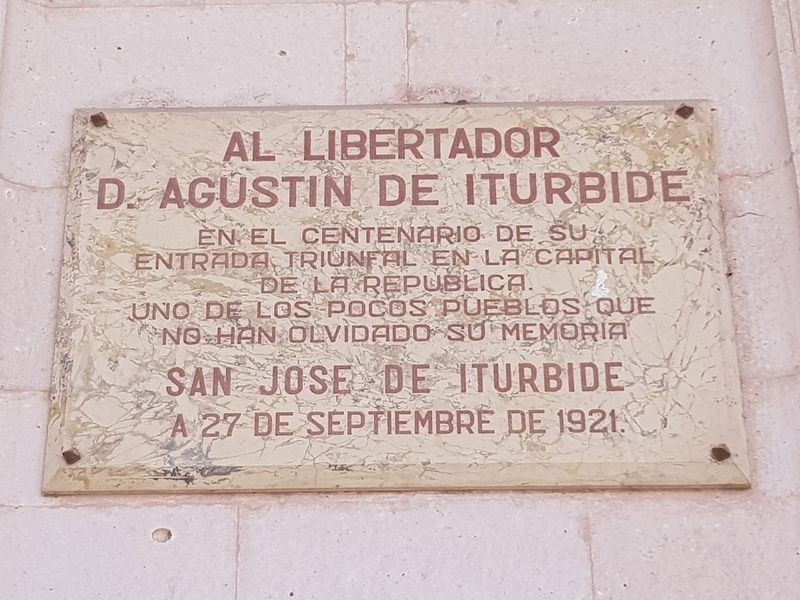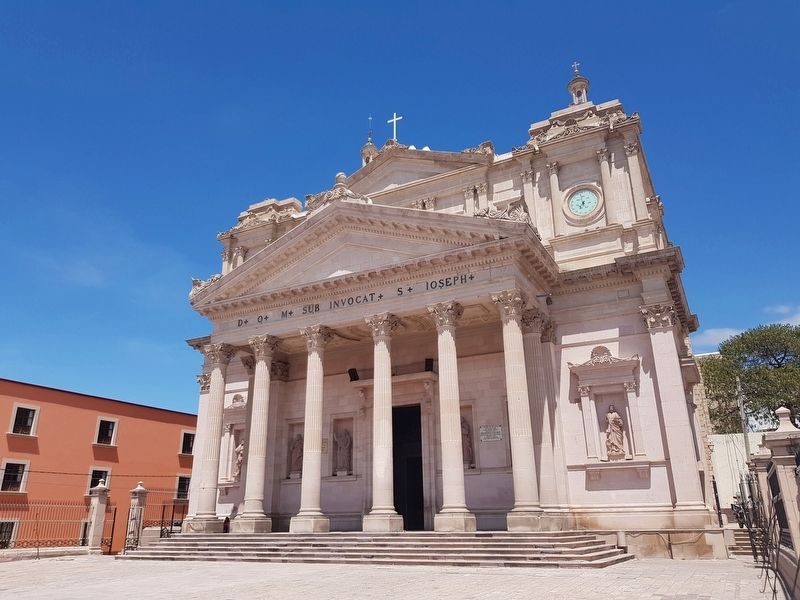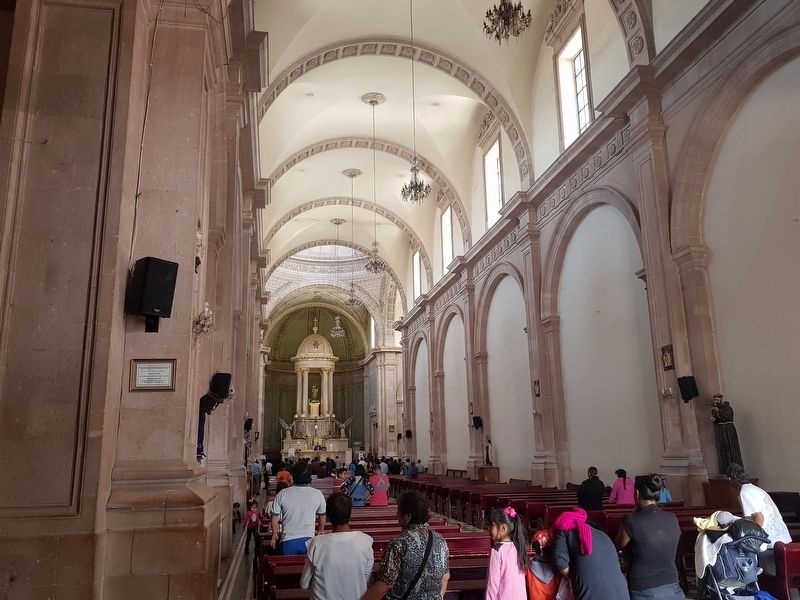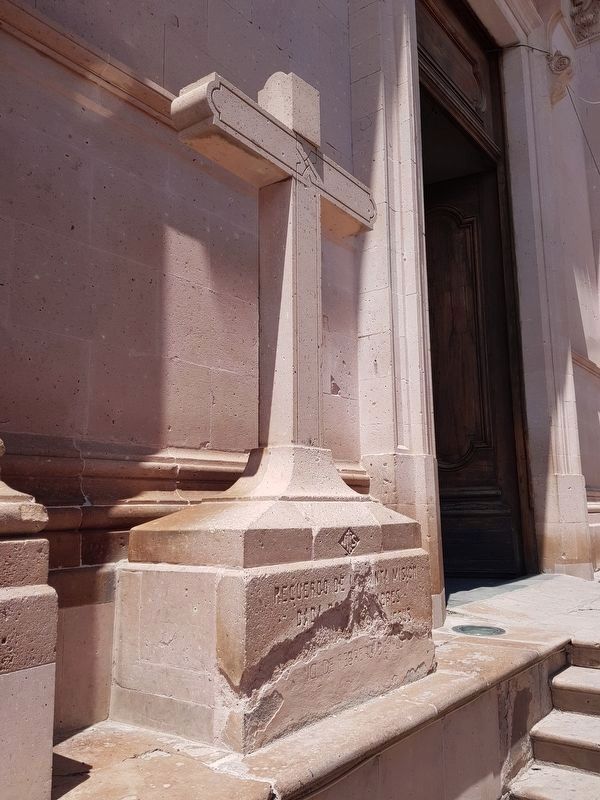San José Iturbide, Guanajuato, Mexico — The Central Highlands (North America)
To the Liberator Agustín Iturbide
D. Agustin de Iturbide
En el centenario de su
entrada triunfal en la capital
de la Republica.
Uno de los pocos pueblos que
no han olvidado su memoria
San Jose de Iturbide
a 27 de septiembre de 1921.
Agustín de Iturbide
On the 100th anniversary of his triumphant entry into the capital of the Republic.
One of the few towns to have not forgotten his memory
San José de Iturbide
September 27, 1921.
Erected 1921.
Topics. This historical marker is listed in these topic lists: Churches & Religion • Colonial Era • Wars, Non-US. A significant historical date for this entry is September 27, 1921.
Location. 20° 59.968′ N, 100° 23.11′ W. Marker is in San José Iturbide, Guanajuato. Marker is on Calle Miguel Hidalgo y Costilla just north of Calle Melchor Ocampo, on the right when traveling north. Touch for map. Marker is in this post office area: San José Iturbide GTO 37980, Mexico. Touch for directions.
Other nearby markers. At least 8 other markers are within 29 kilometers of this marker, measured as the crow flies . History of the City of San José Iturbide, Guanajuato (within shouting distance of this marker); Plaza of the Constituent Congress of 1917 (approx. 0.6 kilometers away); Porfirio Vega Guerrero (approx. 8.1 kilometers away); Fiftieth Anniversary of the Foundation of the Municipality of Dr. Mora (approx. 17.3 kilometers away); Chapel of Former Treasury Buenavista (approx. 21.8 kilometers away in Querétaro); The Arroyo Seco Archaeological Site (approx. 28.3 kilometers away); Rock art in contact (approx. 28.5 kilometers away); The Imagination of Rock Art (approx. 28.5 kilometers away). Touch for a list and map of all markers in San José Iturbide.
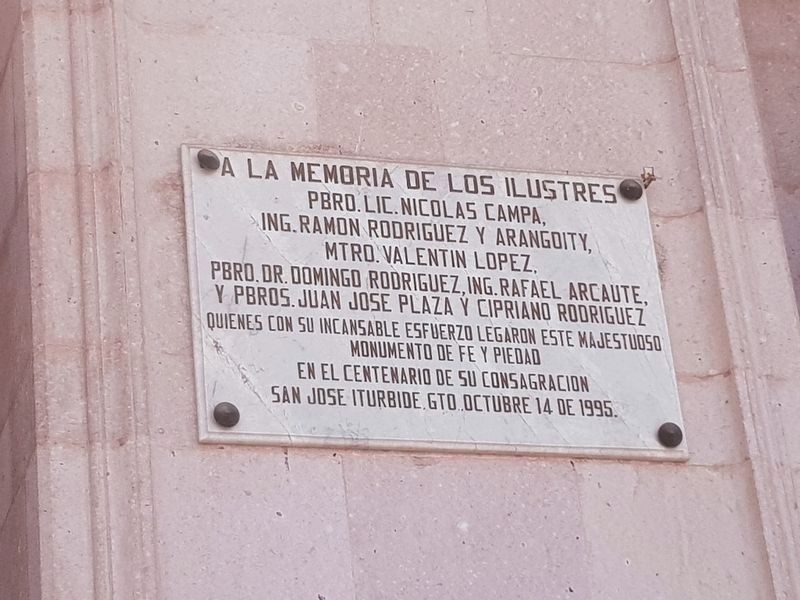
Photographed By J. Makali Bruton, May 6, 2018
4. An additional marker on the front of the San José Parish Church
This 1995 marker names the different church and lay leaders that worked on the church since its consecration in 1885. It reads:
A la memoria de los ilustres
Pbro. Lic. Nicolas Campa, Ing. Rodriguez y Arangoity, Mtro. Valentin Lopez, Pbro. Dr. Domingo Rodriguez, Ing. Rafael Arcaute, y Pbros. Juan Jose Plaza y Cipriano Rodriguez
Quienes con su incansable esfuerzo legaron este majestuoso monumento de fe y piedad
En el centenario de su consagracion
San Jose Iturbide, Gto., Octubre 14 de 1995
Pbro. Lic. Nicolas Campa, Ing. Rodriguez y Arangoity, Mtro. Valentin Lopez, Pbro. Dr. Domingo Rodriguez, Ing. Rafael Arcaute, y Pbros. Juan Jose Plaza y Cipriano Rodriguez
Quienes con su incansable esfuerzo legaron este majestuoso monumento de fe y piedad
En el centenario de su consagracion
San Jose Iturbide, Gto., Octubre 14 de 1995
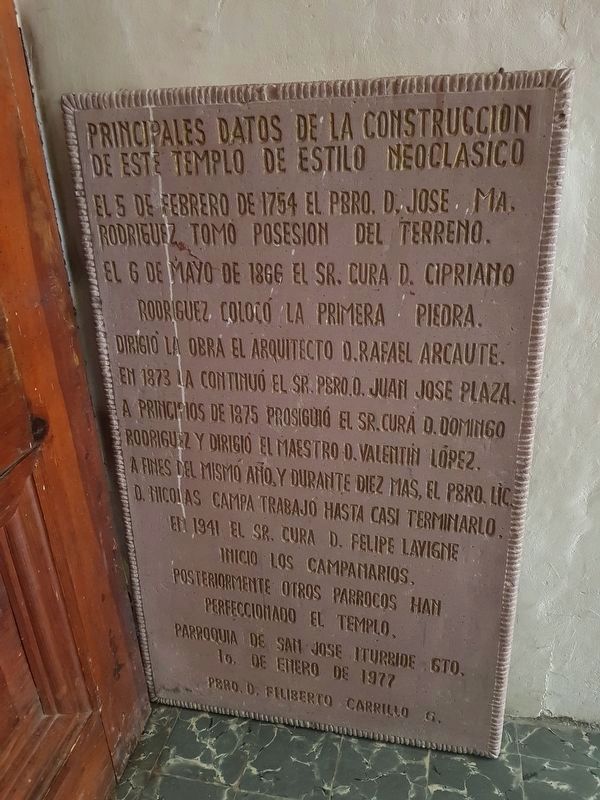
Photographed By J. Makali Bruton, May 6, 2018
6. An additional marker inside the San José Parish Church
This marker was near the entrance to the church, towards the northern wall. It reads:
Principales datos de la construcción de este templo de estilo neoclasico
El 5 de febrero de 1754 el Pbro. D. Jose Ma. Rodriguez tomo posesión del terreno. El 6 de mayo de 1866 el Sr. Cura D. Cipriano Rodriguez colocó la primera piedra. Dirigió la obra el arquitecto D. Rafael Arcaute. En 1873 la continuó el Sr. Pbro. O. Juan Jose Plaza. A principios de 1875 prosiguió el Sr. Cura D. Domingo Rodriguez y dirigió el maestro D. Valentin López. A fines del mismo año, y durante diez mas, el Pbro. Lic. D. Nicolas Campa trabajó hasta casi terminarlo. En 1941 el Sr. Cura D. Felipe Lavigne inicio los campanarios. Posteriormente otros párrocos han perfeccionado el templo.
Parroquia de San Jose Iturbide, Gto.
1º. de enero de 1977
Pbro. D. Filiberto Carrillo G.
English translation:
Important points in the construction of this Neoclassical temple:
On February 5, 1754, Fr. José Ma. Rodríguez took possession of the land. On May 6, 1866 Father Cipriano Rodríguez placed the first stone. The architect D. Rafael Arcaute directed the work. In 1873 Pbr. O. Juan José Plaza continued it. At the beginning of 1875 Father Domingo Rodríguez continued the work and directed the master builder Valentín López. At the end of the same year, and for ten more, the Pbr. Nicolás Campa worked, almost finishing it. In 1941 Father Felipe Lavigne started the bell towers. Later other parish priests have perfected the temple.
Parish of San José Iturbide, Guanajuato, January 1, 1977 – Pbr. Filiberto Carrillo G.
Principales datos de la construcción de este templo de estilo neoclasico
El 5 de febrero de 1754 el Pbro. D. Jose Ma. Rodriguez tomo posesión del terreno. El 6 de mayo de 1866 el Sr. Cura D. Cipriano Rodriguez colocó la primera piedra. Dirigió la obra el arquitecto D. Rafael Arcaute. En 1873 la continuó el Sr. Pbro. O. Juan Jose Plaza. A principios de 1875 prosiguió el Sr. Cura D. Domingo Rodriguez y dirigió el maestro D. Valentin López. A fines del mismo año, y durante diez mas, el Pbro. Lic. D. Nicolas Campa trabajó hasta casi terminarlo. En 1941 el Sr. Cura D. Felipe Lavigne inicio los campanarios. Posteriormente otros párrocos han perfeccionado el templo.
Parroquia de San Jose Iturbide, Gto.
1º. de enero de 1977
Pbro. D. Filiberto Carrillo G.
Important points in the construction of this Neoclassical temple:
On February 5, 1754, Fr. José Ma. Rodríguez took possession of the land. On May 6, 1866 Father Cipriano Rodríguez placed the first stone. The architect D. Rafael Arcaute directed the work. In 1873 Pbr. O. Juan José Plaza continued it. At the beginning of 1875 Father Domingo Rodríguez continued the work and directed the master builder Valentín López. At the end of the same year, and for ten more, the Pbr. Nicolás Campa worked, almost finishing it. In 1941 Father Felipe Lavigne started the bell towers. Later other parish priests have perfected the temple.
Parish of San José Iturbide, Guanajuato, January 1, 1977 – Pbr. Filiberto Carrillo G.
Credits. This page was last revised on March 9, 2021. It was originally submitted on May 30, 2018, by J. Makali Bruton of Accra, Ghana. This page has been viewed 117 times since then and 8 times this year. Photos: 1, 2, 3, 4, 5, 6. submitted on May 30, 2018, by J. Makali Bruton of Accra, Ghana.
